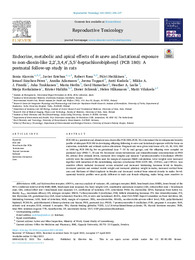Please use this identifier to cite or link to this item:
https://hdl.handle.net/11000/37567Full metadata record
| DC Field | Value | Language |
|---|---|---|
| dc.contributor.author | Alarcon, Sonia | - |
| dc.contributor.author | Esteban Mozo, Javier | - |
| dc.contributor.author | Roos, Robert | - |
| dc.contributor.author | et al. | - |
| dc.contributor.other | Departamentos de la UMH::Biología Aplicada | es_ES |
| dc.date.accessioned | 2025-09-29T12:24:42Z | - |
| dc.date.available | 2025-09-29T12:24:42Z | - |
| dc.date.created | 2021-06 | - |
| dc.identifier.citation | Reproductive Toxicology, Volume 102, June 2021, Pages 109-127 | es_ES |
| dc.identifier.issn | 1873-1708 | - |
| dc.identifier.issn | 0890-6238 | - |
| dc.identifier.uri | https://hdl.handle.net/11000/37567 | - |
| dc.description.abstract | PCB 180 is a persistent and abundant non-dioxin-like PCB (NDL-PCB). We determined the developmental toxicity profile of ultrapure PCB 180 in developing offspring following in utero and lactational exposure with the focus on endocrine, metabolic and retinoid system alterations. Pregnant rats were given total doses of 0, 10, 30, 100, 300 or 1000 mg PCB 180/kg bw on gestational days 7−10 by oral gavage, and the offspring were sampled on postnatal days (PND) 7, 35 and 84. Decreased serum testosterone and triiodothyronine concentrations on PND 84, altered liver retinoid levels, increased liver weights and induced 7-pentoxyresorufin O-dealkylase (PROD) activity were the sensitive effects used for margin of exposure (MoE) calculations. Liver weights were increased together with induction of the metabolizing enzymes cytochrome P450 (CYP) 2B1, CYP3A1, and CYP1A1. Less sensitive effects included decreased serum estradiol and increased luteinizing hormone levels in females, decreased prostate and seminal vesicle weight and increased pituitary weight in males, increased cortical bone area and thickness of tibial diaphysis in females and decreased cortical bone mineral density in males. Developmental toxicity profiles were partly different in male and female offspring, males being more sensitive to increased liver weight, PROD induction and decreased thyroxine concentrations. MoE assessment indicated that the 95th percentile of current maternal PCB 180 concentrations do not exceed the estimated tolerable human lipid-based PCB 180 concentration. Although PCB 180 is much less potent than dioxin-like compounds, it shares several toxicological targets suggesting a potential for interactions. | es_ES |
| dc.format | application/pdf | es_ES |
| dc.format.extent | 19 | es_ES |
| dc.language.iso | eng | es_ES |
| dc.publisher | Elsevier | es_ES |
| dc.rights | info:eu-repo/semantics/openAccess | es_ES |
| dc.rights | Attribution-NonCommercial-NoDerivatives 4.0 Internacional | * |
| dc.rights.uri | http://creativecommons.org/licenses/by-nc-nd/4.0/ | * |
| dc.subject | PCB 180 | es_ES |
| dc.subject | Non-dioxin-like PCBs | es_ES |
| dc.subject | Testosterone | es_ES |
| dc.subject | Thyroid hormones | es_ES |
| dc.subject | Retinoid | es_ES |
| dc.subject | Endocrine disruption | es_ES |
| dc.subject | Liver | es_ES |
| dc.subject.other | CDU::5 - Ciencias puras y naturales::57 - Biología | es_ES |
| dc.title | Endocrine, metabolic and apical effects of in utero and lactational exposure to non-dioxin-like 2,2′,3,4,4′,5,5′-heptachlorobiphenyl (PCB 180): A postnatal follow-up study in rats | es_ES |
| dc.type | info:eu-repo/semantics/article | es_ES |
| dc.relation.publisherversion | https://doi.org/10.1016/j.reprotox.2021.04.004 | es_ES |

View/Open:
Alarcon.pdf
3,24 MB
Adobe PDF
Share:
.png)
